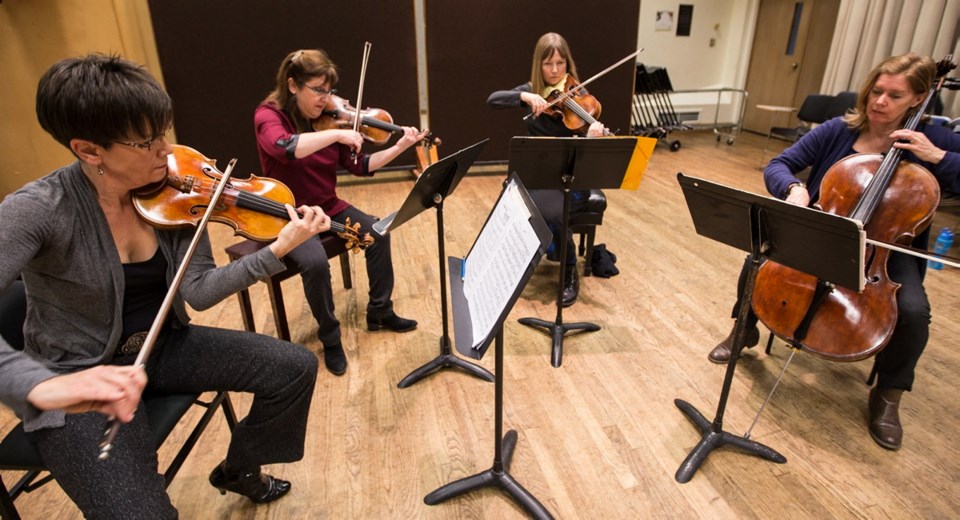Yes, there will be some noteworthy concerts in the coming week — the Victoria Chamber Orchestra, the Victoria Symphony, the visiting clarinetist Kornel Wolak.
But I simply must say something about the Lafayette String Quartet’s Shostakovich cycle, which ended last Friday. The culmination of this beloved ensemble’s 30th-anniversary season, the cycle comprised all 15 of Shostakovich’s quartets performed in chronological order in five concerts spanning a single week.
It was a monumental undertaking, and a triumph.
A Shostakovich cycle, which represents an Everest for any string quartet, had long been on the LSQ’s “bucket list.”
The four women had performed many of the quartets over the years, and recorded Nos. 3 and 8 in the 1990s, for the Dorian label.
But performing all 15, all together — that was new, and boldly ambitious.
Local music-lovers clearly appreciated the project’s importance. The whole cycle (in the University of Victoria’s 220-seat recital hall) sold out, and only a few ticketholders stayed away on the two evenings when Old Man Winter huffed and puffed. (The Feb. 8 concert was moved to Feb. 10 after UVic shut down.)
Lusty ovations greeted every performance. I heard all five concerts (one of them as a recording, while snowbound) and I concur with the crowd.
Here was a real test of the LSQ’s technique, musicianship and professionalism, to say nothing of the musicians’ physical and mental stamina, yet their performances were authoritative, fiercely committed, insightful and bursting with feeling, across the whole astonishing range of these works.
There was plentiful evidence of careful preparation, as I noticed especially when I listened to three of the quartets at home with scores in hand.
The sense of ensemble, of common purpose, was impressive — that’s what comes of performing together for three decades.
And the playing seemed most commanding precisely where the music most demanded concentration and long-range thinking — the big finale of No. 9, the even bigger episodic finale of No. 12, the six slow movements comprising No. 15.
Still, however intelligently considered, this was also “flat-out” playing — brave in the face of challenges, refusing to be tasteful or reserved. The performers were clearly determined to mine everything the music offered, to explore “how far to go too far.”
This meant not only drawing on skill and experience, but giving of themselves with real generosity of spirit.
The big, ardent slow movements (like those in Nos. 2 and 14) throbbed with emotion; the ethereal pianissimo endings held us all rapt. The LSQ seemed to relish every strident dissonance, every weird sonority, every sob and moan and wail, as well as the wit, playfulness and irony in, for instance, Shostakovich’s quirky waltzes and galops.
The women hurled themselves into the furious movements — those in Nos. 3 and 8, for instance, the ferocious fugue in No. 7, and especially the relentless Allegretto furioso of No. 10, which came across as a terrifying shrieking and scraping, an aural assault (extensive retuning was required afterward). Yet when, as so often in Shostakovich, dissonance yielded to sweet, fragile consonance, the result could be heartbreaking.
These performances showed a willingness to “italicize” the music and face its extremes without flinching, an approach that was not only exciting but appropriate: By embracing the sheer strangeness of this music and putting its wild contrasts into high relief, the LSQ revealed something essential about Shostakovich’s style, forcing us to confront the ambiguities in his music and making the notoriously fraught issues around its meaning all the more intriguing and pressing.
Admittedly, the music they were playing was rarely joyful, yet the quartet’s own joy in tackling this project was palpable, and they succeeded in communicating both their love for the music and their deep sympathy for the beleaguered Shostakovich.
(In early April, the LSQ will repeat the cycle for the Kitchener-Waterloo Chamber Music Society, in Ontario.)
Though the women of the Lafayette String Quartet have been artists-in-residence at UVic since 1991, they are nowhere near the end of their performing careers.
It’s hard to imagine that they could ever top this extraordinary Shostakovich cycle. But knowing them, they’ll try. How lucky we are.



